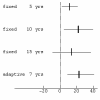Statistical issues in randomized trials of cancer screening
- PMID: 12238954
- PMCID: PMC130026
- DOI: 10.1186/1471-2288-2-11
Statistical issues in randomized trials of cancer screening
Abstract
Background: The evaluation of randomized trials for cancer screening involves special statistical considerations not found in therapeutic trials. Although some of these issues have been discussed previously, we present important recent and new methodologies.
Methods: Our emphasis is on simple approaches.
Results: We make the following recommendations: (1) Use death from cancer as the primary endpoint, but review death records carefully and report all causes of death; (2) Use a simple "causal" estimate to adjust for nonattendance and contamination occurring immediately after randomization; (3) Use a simple adaptive estimate to adjust for dilution in follow-up after the last screen
Conclusion: The proposed guidelines combine recent methodological work on screening endpoints and noncompliance/contamination with a new adaptive method to adjust for dilution in a study where follow-up continues after the last screen. These guidelines ensure good practice in the design and analysis of randomized trials of cancer screening.
Figures

Similar articles
-
Noncompliance in cancer screening trials.Clin Trials. 2007;4(4):341-9. doi: 10.1177/1740774507081341. Clin Trials. 2007. PMID: 17848495
-
Design of cancer screening trials/randomized trials for evaluation of cancer screening.World J Surg. 2006 Jul;30(7):1152-62. doi: 10.1007/s00268-006-0074-9. World J Surg. 2006. PMID: 16794902 Review. No abstract available.
-
Statistical considerations for the next generation of clinical trials.Semin Oncol. 2011 Aug;38(4):598-604. doi: 10.1053/j.seminoncol.2011.05.014. Semin Oncol. 2011. PMID: 21810519 Review.
-
Methodological issues in the use of composite endpoints in clinical trials: examples from the HIV field.Clin Trials. 2010 Feb;7(1):19-35. doi: 10.1177/1740774509356117. Clin Trials. 2010. PMID: 20156955 Review.
-
Statistical considerations for noninferiority/equivalence trials in vaccine development.J Biopharm Stat. 2006;16(4):429-41. doi: 10.1080/10543400600719251. J Biopharm Stat. 2006. PMID: 16892905 Review.
Cited by
-
Limitations in the Effect of Screening on Breast Cancer Mortality.J Clin Oncol. 2018 Oct 20;36(30):2988-2994. doi: 10.1200/JCO.2018.78.0270. Epub 2018 Sep 4. J Clin Oncol. 2018. PMID: 30179570 Free PMC article.
-
Breast cancer mortality in participants of the Norwegian Breast Cancer Screening Program.Cancer. 2013 Sep 1;119(17):3106-12. doi: 10.1002/cncr.28174. Epub 2013 May 29. Cancer. 2013. PMID: 23720226 Free PMC article.
-
Using observational data to estimate an upper bound on the reduction in cancer mortality due to periodic screening.BMC Med Res Methodol. 2003 Mar 6;3:4. doi: 10.1186/1471-2288-3-4. Epub 2003 Mar 6. BMC Med Res Methodol. 2003. PMID: 12689345 Free PMC article.
-
The WISDOM Personalized Breast Cancer Screening Trial: Simulation Study to Assess Potential Bias and Analytic Approaches.JNCI Cancer Spectr. 2019 Jan 8;2(4):pky067. doi: 10.1093/jncics/pky067. eCollection 2018 Oct. JNCI Cancer Spectr. 2019. PMID: 31360882 Free PMC article.
-
Causal Proportional Hazards Estimation with a Binary Instrumental Variable.Stat Sin. 2021 Apr;31(2):673-699. doi: 10.5705/ss.202019.0096. Stat Sin. 2021. PMID: 34970068 Free PMC article.
References
-
- Etzioni RD, Connor RJ, Prorok PC, Self SG. Design and analysis of cancer screening trials. Statistical Methods in Medical Research. 1995;4:3–17. - PubMed
-
- Glasziou PP. Meta-analysis adjusting for compliance: The example of screening for breast cancer. Journal of Clinical Epidemiology. 1992:1251–1256. - PubMed
Publication types
MeSH terms
LinkOut - more resources
Full Text Sources

